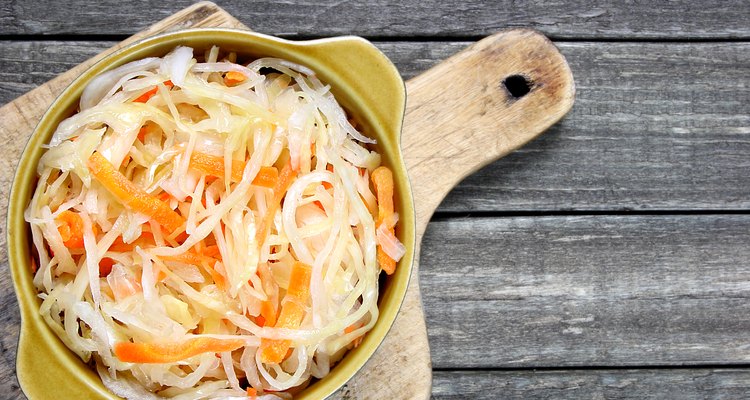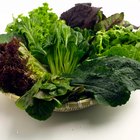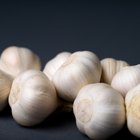
papkin/iStock/GettyImages
Sauerkraut brings out the best in a freshly grilled sausage, with its tart cruch, but it's much more than a tangy condiment. It's one of the glories of European peasant cookery, treasured from France all the way through to the Slavic countries of the vast Eastern European heartland. When it's slow-cooked in the traditional fashion, its sharp acidity mellows and the sauerkraut becomes infused with the rich flavors of the meats, herbs and spices it's simmered with.
Start With Aromatics
Seasoning sauerkraut for long-cooking dishes usually begins with a handful of aromatic ingredients. These vary, depending on your culinary heritage, but onions are almost universal. Their sweet and savory notes complement the fermented cabbage beautifully, and the onion and kraut are almost indistinguishable once cooked. Many recipes add garlic as well, especially recipes from Eastern Europe. Another common addition at the beginning is something sweet to balance the sauerkraut's acidity, which might be carrots, apples or even shredded fresh cabbage. All of these contribute to the kraut's final flavor, though they aren't necessarily thought of as seasonings.
Common Spices and Herbs
A number of herbs and spices are commonly used in cooking sauerkraut, giving it a base of flavors that can be adjusted slightly to work with different regional cuisines. Bay leaves are a common addition, for example, giving a distinctive note that's immediately noticeable despite the bold flavor of the sauerkraut. Juniper berries are another widely used addition, bringing a peppery and woodsy flavor to the pot. Cooks from Germany and other Middle-European countries often add caraway seed, with its hint of licorice. Further east, paprika and dill are often added. Whole peppercorns are nearly universal--they add a pleasant peppery bite without being harsh or overpowering--and both coriander and cumin are quite compatible with sauerkraut's flavors.
Creating Your Own Tradition
When you're deciding how to season sauerkraut, you don't necessarily need to be bound by tradition. You're pleasing your own palate, after all, so combine flavors that you've liked together in the past. Hot and sour flavors complement each other nicely, for example, so you might opt to add a dash of cayenne or even whole dried chilies to your sauerkraut. Adding fresh ginger, and finishing it with toasted sesame oil, would give it a definite Asian spin. You could also raid your cupboard for flavors that parallel some of the more traditional options: Fennel seed and star anise have flavors similar to caraway, for example, while cardamoms have some of the resinous evergreen notes you'd find in juniper berries.
Let the Meat Set the Tone
One useful rule when considering how to season sauerkraut is letting the meat be your guide. Your chosen herbs, spices and aromatics should be compatible with whatever meat you're cooking in the sauerkraut or serving alongside it. Fresh meats and poultry are very different from their cured or smoked equivalents, and there's a world of difference between sausages, so combinations that work with one won't necessarily work with others. Before you add a seasoning to the sauerkraut, take a moment to "taste" it mentally and ask yourself how it will go with the meat or sausage you've built the meal around. If you can't picture them working well together, they probably won't.
Related Articles

How to Cook Pork & Sauerkraut in an ...

Italian Cooking Term for Celery, ...

Are Juniper Berries the Same As Capers?

What Can I Make With Cajun Pork Tasso?

How to Reduce the Strong Taste of ...

What Herbs & Spices Flavor Fish?

What Foods Can I Put Fresh Ginger On?

What Herbs Go With Veal Chops?

Quesadilla Spices

How to Cook Mustard Greens Cajun Style

Classic Russian Spices

Baking Fresh Kielbasa

How to Cook Sauerkraut and Kielbasa ...

How to Cook With Pineapple Sage

How to Marinate a Pork Shoulder

What Is a Good Way to Cook Cubed Pork?

What Meat Goes Well With Boiled Cabbage?

Ways to Cook Beer & Onions With Smoked ...

Can I Substitute Mustard for Moutarde ...

How to Blanch and Peel Garlic
References
Writer Bio
Fred Decker is a trained chef and prolific freelance writer. In previous careers, he sold insurance and mutual funds, and was a longtime retailer. He was educated at Memorial University of Newfoundland and the Northern Alberta Institute of Technology. His articles have appeared on numerous home and garden sites including GoneOutdoors, TheNest and eHow.